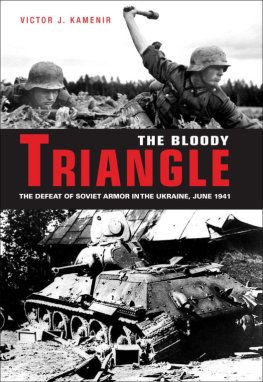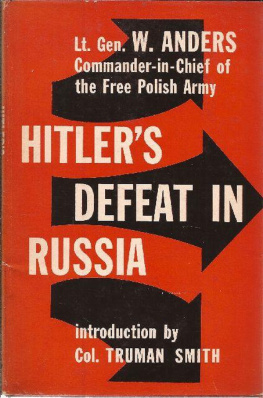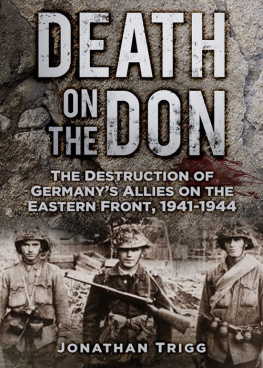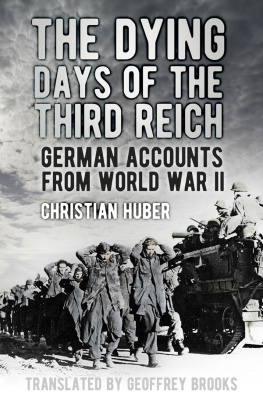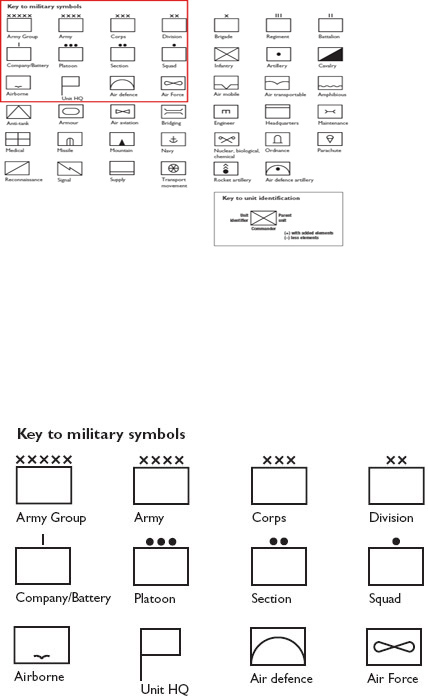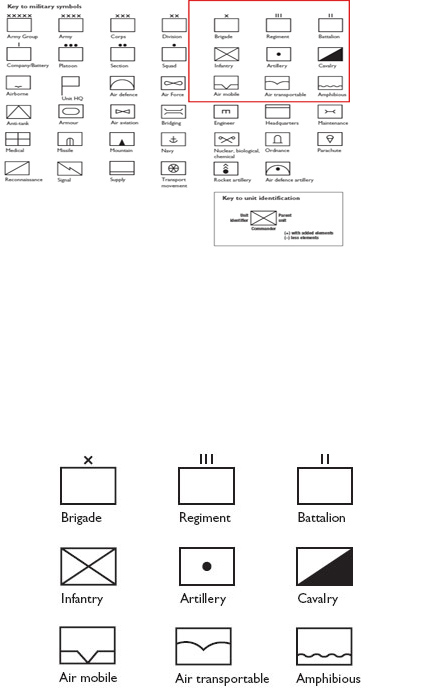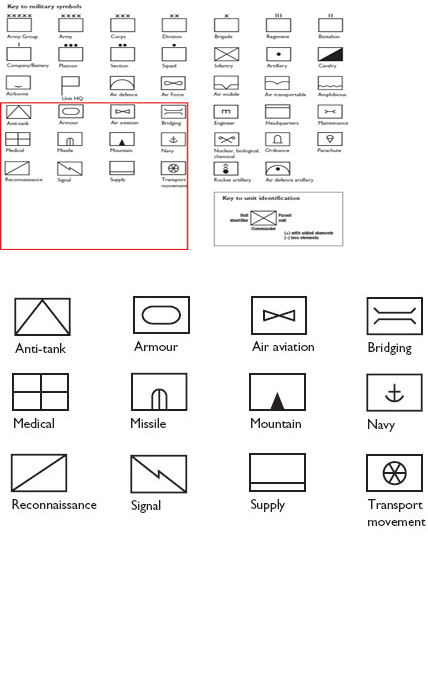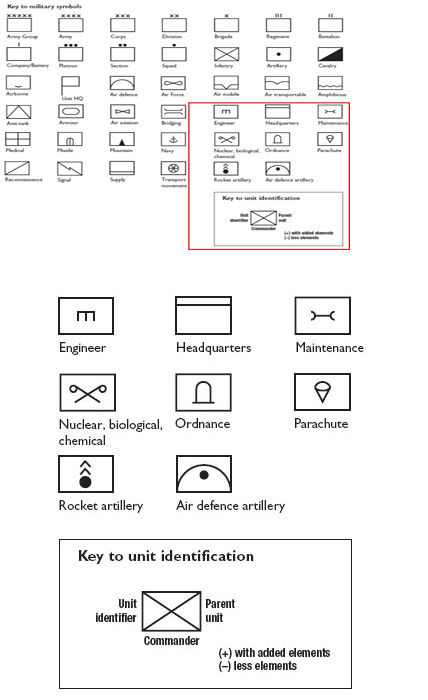AUTHRS NOTE
This is a revised and substantially expanded version of the text used in Ospreys illustrated history of the Russo-German conflict, Ostfront, published in 1998. It is a military history, which is not to say that it is solely concerned with generals and tanks, but that it incorporates almost every other historical discipline. Political history is obviously crucial to this story; but so is economic, social, religious and technological history, and not just of Germany and Russia but of all the belligerent nations in the Second World War.
The political transformation of eastern Europe and the former Soviet Union during the 1990s renders redundant both the phraseology and the spelling of earlier histories of this war. For instance, wartime German accounts refer to their enemies as Russian. Of course, their opponents came from all the constituent republics of the USSR. The Union of Soviet Socialist Republics had a population of about 190 million in 1940: it included 170 discrete races, which spoke 140 different languages. However, 14 of these peoples made up 94 per cent of the total: 90 million Great Russians, 40 million Ukranians, and ten million White Russians. Many are now independent nations, but in the days of the USSR it was politically correct to call everyone Soviet. On the other hand, even President Gorbachev could slip up in public and say Russian when he meant Soviet. This book uses the two expressions interchangeably. I have been equally haphazard with the expressions Red Army and Soviet Army. The USSRs army was officially re-titled the Soviet Army in 1944, but its opponents called them Reds until the end of the war, and subsequent publications tend to use both phrases indiscriminately.
Place names in this story are a minefield of linguistic and political traps. Stalin shifted the Polish frontier westwards after the war, so many German place names are now Polish. After storming the coastal fortress of Knigsberg in 1945, the Soviets seized the area for themselves and renamed it Kaliningrad; it remains a political and geographic anomaly, still awaiting resolution today. German place names throughout the Baltic Republics have changed. Leningrad has reverted to being St Petersburg. The industrial centre of Kharkov is more correctly Charkov when transliterated from Russian, and modern maps spell it in its Ukranian rendition, Harkiv. I have stuck to Kharkov, since this is the form used in most books published in the last 50 years, and I apply the same policy to other towns and cities.
Statistics are unavoidable in this narrative, but by nature unreliable. This conflict was won as much on the factory floors as on the battlefields, but few published sets of figures for German and Russian wartime manufacturing totals agree. There are similar problems assessing numbers of vehicles or aircraft actually serviceable at any given time. Many numbers that have been quoted in book after book turn out to have no reliable basis in original wartime documents. P. J. ORourkes first law of social sciences says that The more precise the figure, the more general the lie. Unfortunately, numbers do matter. German intelligence persistently underestimated Red Army strength by about 20 per cent a million men from 1943. Hitler never believed the summaries of Russian production he received, perhaps because they suggested he should start packing for South America right away. The salient point that will emerge is that Russian tank factories built more T-34s than the sum total of Panzer IIs, Panzer IIIs, Panzer IVs, Panthers, Tigers and other exotica that German industry assembled, and America built more M4 Shermans than the Russians built T-34s. For impressively long periods, even the British were building tanks and aircraft faster than the Germans. With almost the whole of the European coal and steel industry under its control, the German war economy failed miserably to provide the weapons its army required.

CONTENTS
INTRODUCTION
Poland will be depopulated and settled with Germans ... As for the rest ... the fate of Russia will be exactly the same.
ADOLF HITLER
F or many German families the Second World War is synonymous with the Russian front. It was where the overwhelming majority of German servicemen fought, and where more than three-quarters of their 3.9 million dead lie buried. In 1945 the Russian front came to Germany. It engulfed East Prussia and Saxony, and surged all the way to the Elbe, while two million Soviet soldiers stormed Berlin, the would-be capital of Hitlers Thousand Year Reich.
The Second World War is known in Russia as The Great Patriotic War. If the war only became truly patriotic after the invaders were exposed as genocidal enslavers and not the liberators many people had hoped them to be, there was no doubting its great scale. Hitlers invasion pitted the largest national armies ever assembled against each other. The front stretched from the Arctic Circle to the shores of the Black Sea. Operations took place over unprecedented distances. German forces advanced more than 1,000 miles into the Soviet Union; at its greatest extent, their operational front stretched to nearly 2,000 miles. Individual campaigns took place over greater areas than previous wars. The gap smashed in the German lines by the Soviet winter offensive in December 1942 was wider than the entire Western Front in the First World War.
It is salutary to compare the scale of operations on the Russian front with those in western Europe. In August 1944, 38 Allied divisions fighting on a 75-mile front in France encircled 20 German divisions; after 27 days combat, they destroyed the German forces in Normandy and took 90,000 prisoners. At the same time the Soviet forces mounted three offensives. Along the borders of Romania 92 Soviet divisions and 6 tank/mechanized corps attacked 47 German and Romanian divisions on a frontage of 450 miles; they encircled 18 German divisions and took 100,000 prisoners in a week. Meanwhile, 86 Soviet divisions and 10 tank/mechanized corps attacked across southern Poland and destroyed nearly 40 German divisions in the process. The third Soviet offensive, which had been under way since 22 June, involved 172 divisions and 12 tank/mechanized corps in an advance of 400 miles along a 600-mile front; it overwhelmed 67 German divisions, of which 17 were never to reappear on the German order of battle.
By late 1944 there were 91 Allied divisions in France, Belgium and the Netherlands, facing 65 German divisions across a 250-mile front. In the east, 560 Soviet divisions were fighting 235 German divisions across a 2,000-mile front, driving them rapidly westwards. So there is a strong argument that the Soviet Union had already won the war by 1944, whether the western Allies finally opened a second front or not.



